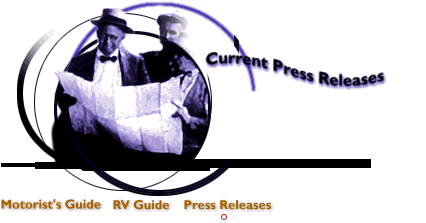
 |
|
The Tire Industry Safety Council urges owners of recreational vehicles to pay close attention to their vehicle weight, load distribution, and tire inflation pressure before heading off on their next road trip. "RV owners who take the time to check their tires for proper inflation and loading can avoid the aggravation and expense of a possible breakdown on the road," says Council Chairman Donald B. Shea. He adds that proper tire care is especially important because most RVs are out of service for long periods and then often used frequently at near maximum loads, particularly during the hot summer months. "RV owners should check their tires at least once a month, and always before starting any extended trip," Shea says. Inflation pressures should be checked when tires are cold, as heat generated during driving temporarily increases air pressure above the recommended cold inflation pressure. This is normal, so never "bleed" air from a hot tire, as this could result in dangerous underinflation. Since many gas station air towers can be inaccurate due to exposure or abuse, Shea advises RV enthusiasts to carry their own tire inflation gauges, calibrated up to 120 psi. Once you are sure your tires are properly inflated, the next important thing is to be sure not to overload your vehicle. "Vehicle overloading is a leading cause of RV tire failure," Shea notes. Your RV tire has maximum inflation and load capacity information molded into its sidewall; and all RVs built since 1972 also have a certification label which contains the following important information:
Even if your tires are the recommended size and load range for your vehicle, the only way you can be sure they are not overloaded is to weigh, axle by axle and side to side, your fully-loaded vehicle on reliable platform scales. Such weighing services are available at many highway weighing stations or building supply depots. Consult your Yellow Pages under "weighers" or "weighing" for the location of the nearest scales. Make sure you weigh each axle of the loaded vehicle separately. The Council offers these additional RV tire care and safety tips:
The Council also warns RV owners not to "bleed" tires to reduce air pressure build-up or overinflate beyond recommended limits in an attempt to compensate for heavy loads. The Council offers a free brochure on recreational vehicle tire care for cars and light trucks. To order the guide, send a self-addressed, stamped business-size envelope to: Tire Industry Safety Council, P.O. Box 3147, Medina, OH 44258. The Council also offers an RV tire care kit which includes a professional dual-head air pressure gauge, a tread depth gauge, eight metal valve caps and an RV tire care brochure. To order a kit, send a check or money order for $14.95 plus $3.50 shipping and handling to the above address.
|